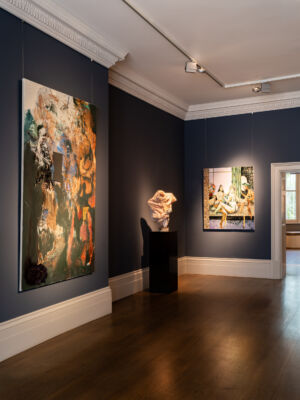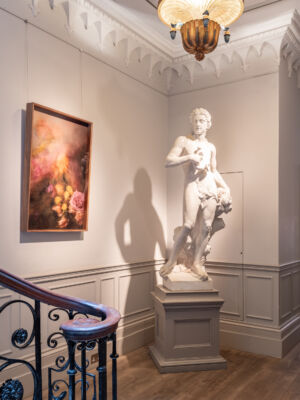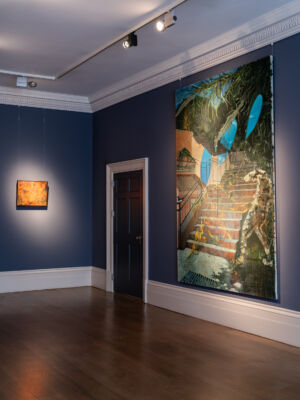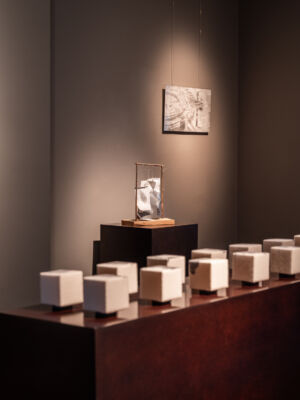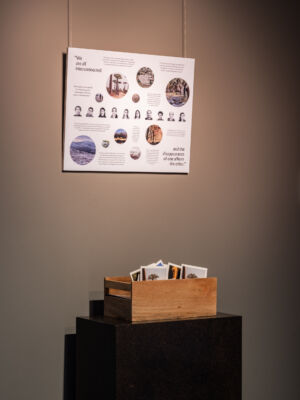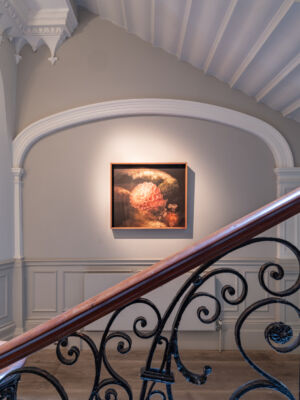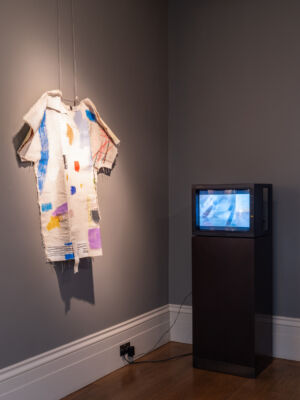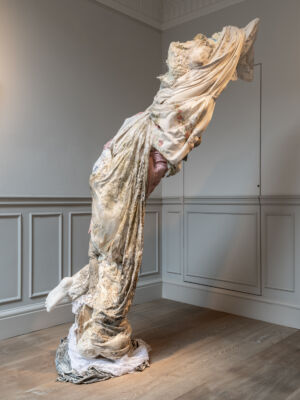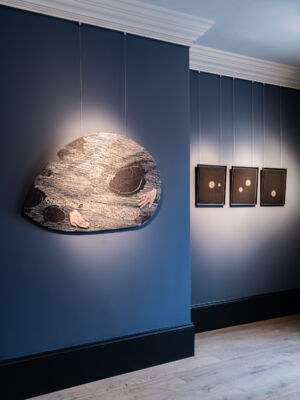‘On Tenderness & Time’
Curated by Jenn Ellis
Presented by Xenia Creative Retreat
Danielle Barkat, Marcus Cope, Abbie Griffiths, Nicola Gunnarsson, Mark Jackson, Liang-Jung Chen, Jessie Makinson, Richard McVetis, Sari Nordman, Aimee Parrott, Oren Pinhassi
Kevin Pinsembert, Marty Schnapf, Gillies Adamson Semple, Dean Sidaway, Yael Weiser and Sarah Kate Wilson.
April 25th – May 3rd, 2024. Daniel Katz Gallery, 6 Hill Street, London, W1J 5N

Oren Pinhassi, I Do Not Fear Time (Guardian), Aimée Parrot, Cyclone, Marty Schnapf, Cherry Blossoms and Mark Jackson, racing siberian. Photography by James Retief
“The journey of a thousand miles begins with a single step.” – Lao Tzu
On the course of a journey there’s the important facet of who you meet along the way; what that interaction is like, what sentiment it leaves you with – that lingering and primordial aftereffect. One of the most important journeys is with yourself, as you spend time in a place and evolve. In the case of being creative, this is through the acts of not only making, but also pausing, reflecting, sitting with your thoughts and having space to let your practice unfold. Such spaces are rare – and Xenia is such a space, and community. Beyond its bucolic location in the North Hampshire countryside, the retreat encapsulates in its name alone an ancient welcome. In The Odyssey, and the lives of the ancient Greeks, “xenia” was the Greek word for hospitality. But it was not quite as we understand the act of welcoming others today: it was a moral code that mandated respect and generosity for any visitor, whether a friend, a guest, or a foreigner. Indeed, when tracing the etymology of the term “xenia”, it originates from the word “xenos,” which means “stranger.”
Spend enough time in a place – creating, ideating – and you’ll start to perhaps, at times, feel like a stranger to yourself. With a bit of distance, things are felt and seen a little differently. Heightened, it could be a wave of inspiration, the tickle of boredom, a numbness of discomfort, or the double edged trope of mental block and inspirational burst. Such are the seismographic waves of pausing, a variable and necessary set of conditions for tapping into new thought. An emotional range, and nuanced balance between discomfort and softness, that sets the scene for our exhibition ‘On Tenderness & Time’, which brings together 17 residents from 2022-2023: Yael Weiser, Dean Sidaway, Aimee Parrott, Liang-Jung Chen, Richard McVetis, Jessie Makinson, Oren Pinhassi, Marcus Cope, Sarah Kate Wilson, Kevin Pinsembert, Danielle Barkat, Sari Nordman, Nicola Gunnarsson, Abbie Griffiths, Marty Schnapf, Gillies Adamson Semple, Mark Jackson.
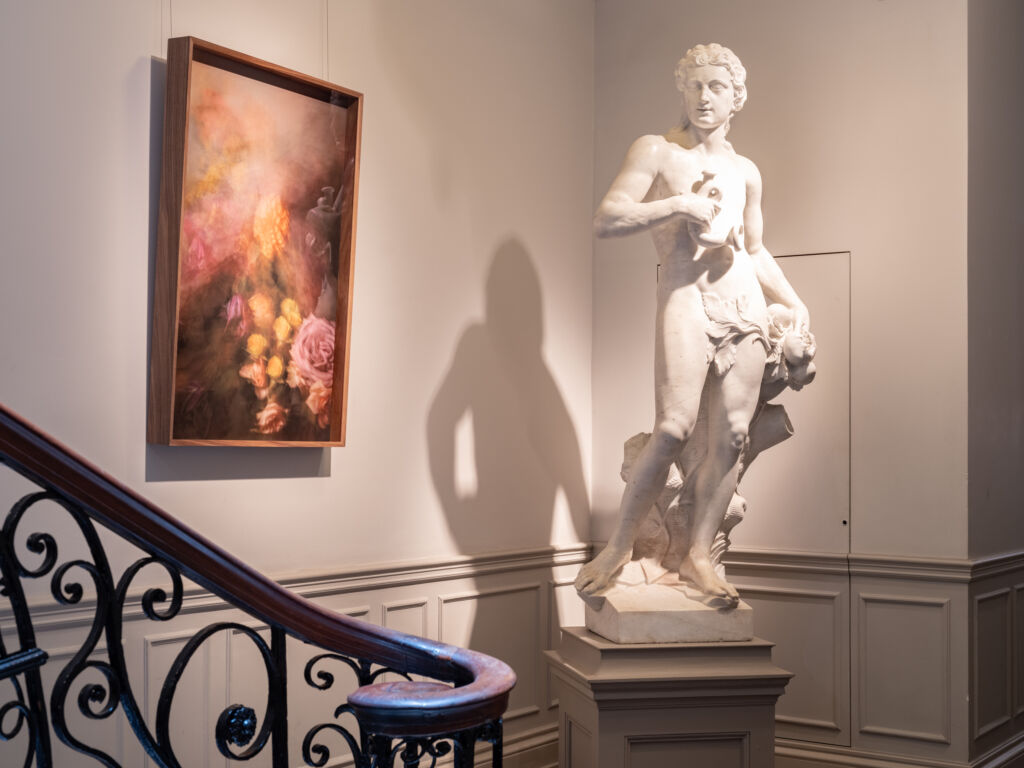
Danielle Bakart, English Bouquet 01. Photography by James Retief
Working across a range of mediums the exhibition is at once a survey but also a moment of dialogue – an exercise in finding commonality. Brought together by each artist’s shared experience at Xenia rather than strict conceptual pursuits, ‘On Tenderness & Time’ explores the elemental care of each practice. Set in London for the first time, in a Georgian townhouse, home to Daniel Katz Gallery that holds many ancient to modern gems, the exhibition also probes a consideration of the past to the present. Finding points of connection between the artists and their works, the exhibition is split into three parts. On the ground floor, across two rooms, we first explore a conversation centred around corporeal considerations, whether gestural expressions or moments of personal surmountment. We then pass on to a second adjacent room that reflects responses to rhythm and movement, whether it be of our daily lives or celestial patterns. Over in a third room, on the second floor, is a dedicated reading room. Here, one is encouraged to spend time with Xenia’s third publication and past volumes: to take a little time in this pocket of tranquillity; to not just see but also absorb.
In thinking about the term ‘tenderness’ there is an immediate nurture that comes to mind, an elemental connection to the body in its various states and forms. Conveying a sense of softness as well as delicacy and precarity is an opening work by Danielle Barkat, a photograph and part of her new ‘English Bouquet’ series, where it appears as if she’s painted with flowers, capturing their whisk and ephemerality through the lens. Also introducing flora, but through the lens of rebirth and overcoming, is a self-reflective photographic work by Yael Weiser depicting a bouquet draped across a wheelchair – a reference to Weiser’s rehabilitation process following a stroke in her early 30s. Across, is the sculpture work by Oren Pinhassi, depicting a humanoid yet architectural figure perched atop a rock. Composed of a metal frame and covered in sand, it speaks to a liminal fragility while also prompting thought around living ecologies and physical layers. Speaking of fossils, trace – what is embedded and held as well as lost – is the work of Aimee Parrott. On the canvas she paints, removes, adds and unravels; tender and textural, anthropomorphic shapes reveal fused pigments and filaments.

Liang-Jung Chen, Open Circuit and Close Circuit Test, Nicola Gunarsson, Untitled, Gillies Adamson Semple, Maquette 002 and Aalto, and Richard McVetis, Variations of a Stitched Cube. Photography by James Retief
Shifting over, we encounter a dialogue around evolving figuration between Marty Schnapf and Mark Jackson. Entitled ‘Cherry Blossoms’, Schnapf’s painting depicts a woman’s face with delicate features; eyes, mouth, nose, the hint of an eyebrow. There is a sense of movement through the erasure of paint as if, in a swoop, motion is conveyed and an instance articulated. A fluid pluralism, between abstraction and depiction is also explored in Mark Jackson’s work, which layer upon layer builds different presences; the whisper of a torso, the outline of a feline eye. Permeating Jackson’s work is a sense of touch, revel and reveal, as pigments and textures layer and build. Emphasising a sense of touch and memory, are the sculptural works by Abbie Griffiths, which combine plaster and collected bed sheets. Thinking of skin and touch, her works speak to intimacy, domesticity, as well as the languages of Classicism. Echoing elements of touch, and extending it over to the realm of sensuality, femininity and play is the work of Jessie Makinson. Somewhat otherworldly, there’s a sense of dream, a poetic fiction that’s conveyed.
On the opposite wall we encounter works by Marcus Cope and Sarah Kate Wilson, which each explore tenderness through an angle of personal prevail. Presented for the first time is a new painting by Cope, which shows a recurring motif in his paintings: an outdoor staircase he photographed in Cyprus where his young daughter is standing between the levels. Mnemonic and multi-layered, his paintings tell a story; in this case two figures, one more dense and the other outlined by fire, seem to battle each other in the forefront. The balance between memories of joy and pain are finely balanced, echoing the daily reality of holding a mixture of sentiments. In conversation with this duality is the work of Wilson, which speaks to memory, pigment and trace, but also ideas of growth. A multi-disciplinary artist working across performance, painting, textile; this work holds that plurality, while also expanding on the thought of what do we leave behind? What memories do we let take hold?
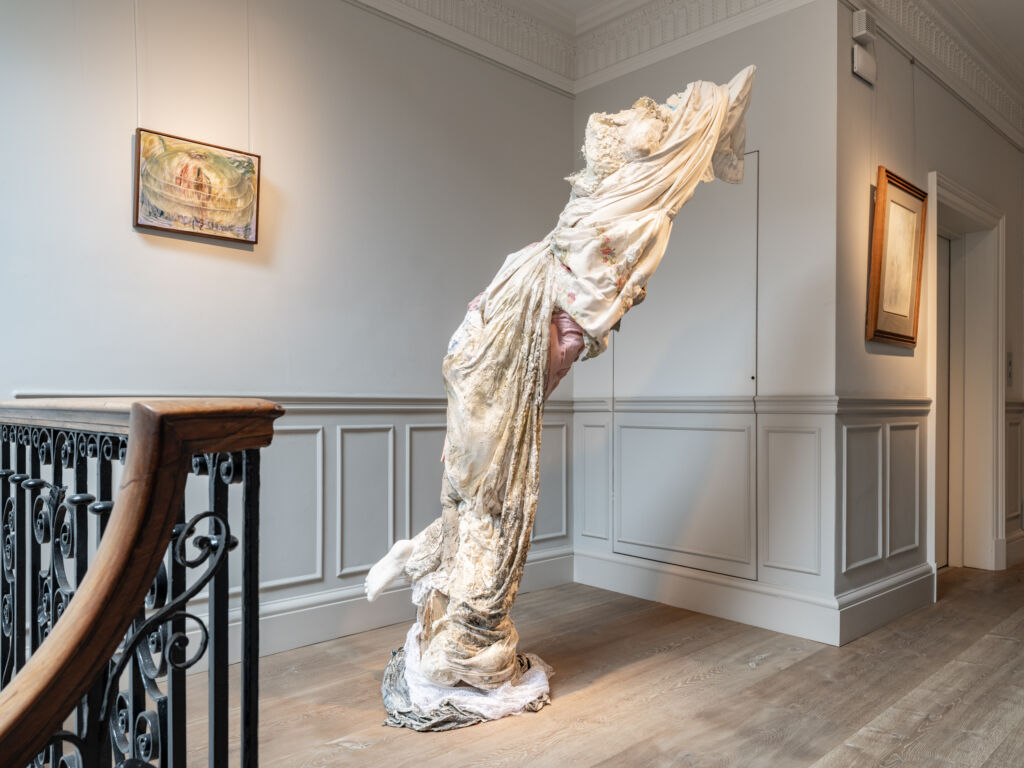
Aimée Parrot, Fruiting body, and Abbie Griffiths, Urn Dream. Photography by James Retief
Stepping through to the second room we meet a slightly different set of conversations; ones that explore our overarching themes but through an increased sense of finding order in our environment. Near meditative, there is a patterning see observational enquiry that is channelled and emerges. We first discover the work of Richard McVetis; intricate cubes, which he has individually stitched and laid out as rhythmic insights into a constellation. Through their minutiae they speak to the volumes of the universe, its nebulae, but equally the crepuscules of the moon and its formations. Sharing the language of delicacy, movement and formation, a module by Gillies Adamson Semple stands atop a plinth, existing in a state between gravitational pull and wispy flight. Alongside is a new work, part of Semple’s ‘Aalto’ series, that at once references the architectural great Alvar Aalto and counter-reveals snippets of everyday life and space.
Speaking to the quotidian, what we observe, hold but also wear, is the work of Nicola Gunnarsson. Combining fabrics and textiles with the delicate stitching of beads and pointed overlay, there is an exchange to be had with McVetis’ work. Equally, through their nod to garment and wear, they speak to Dean Sidaway’s canvas dress work, created while at Xenia, that follows from his background in Fashion and interest in exploring the intersections of art, music, dance, and movement. Displaying his interdisciplinarity and the work’s background is an accompanying video work, expanding on the creative process while including visuals of Xenia and its creation in the retreat’s studio. Also thinking of stitch and thread but also luminosity and meditative entangling is a new work created for the exhibition by Liang-Jung Chen. Composed of metal wire, circuit boards and tiny bulbs, there is a celestial near planetary feel, while speaking back to the ordinary, the technological shift of our age, the balance we seek with nature and a welcomed lack of connectivity.
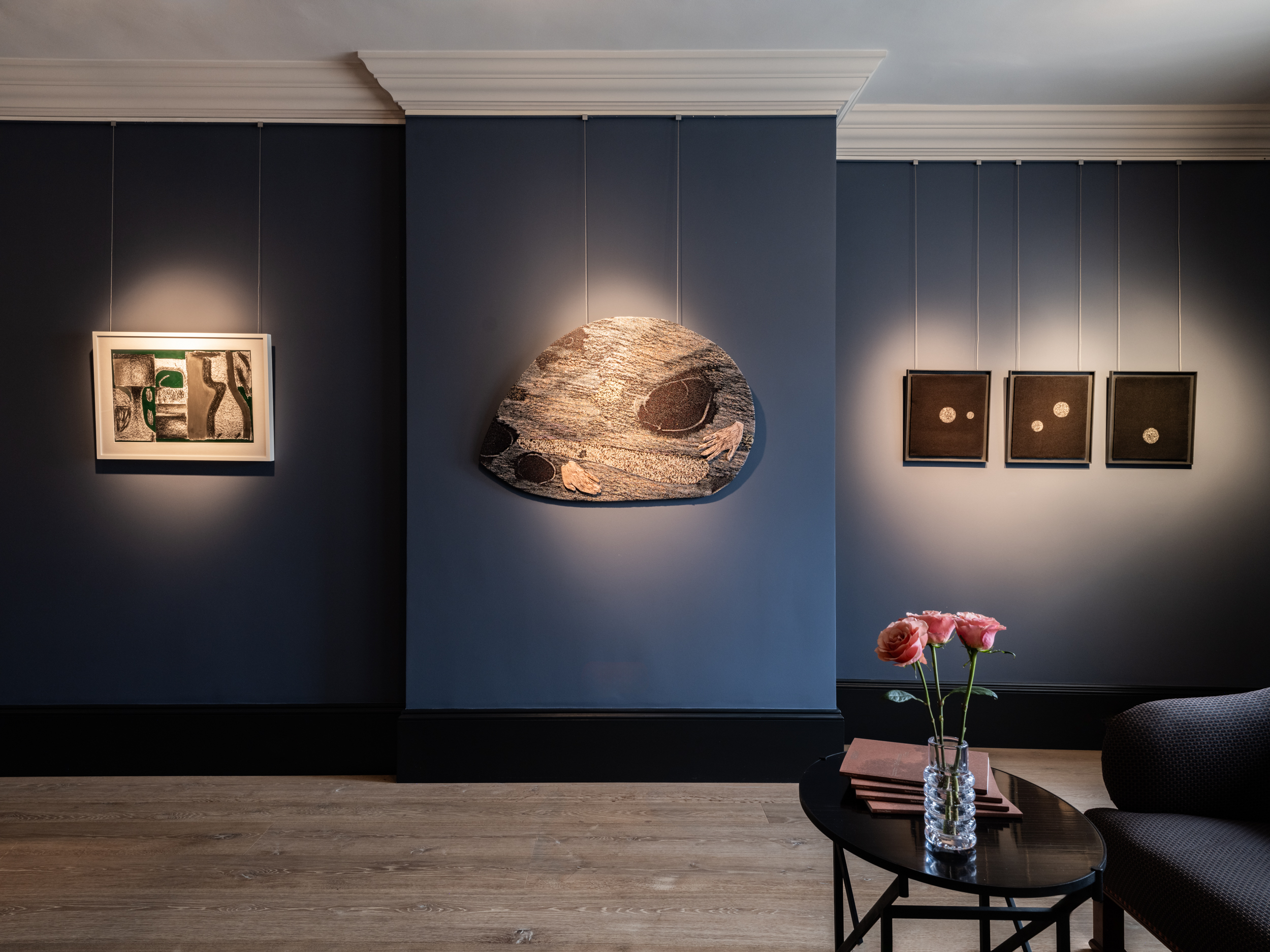
Kevin Pisembert, Post Acier Vase, Sarah Kate Wilson, Faunule, and Richard McVetis, White Circles in Black III, IV, V. Photography by James Retief
Finally, reflecting on our shared lived environment, are the works by Kevin Pinsembert and Sari Nordman. Pinsembert, whose background is as a street artist, speaks to the urban landscape, the rhythm of the quotidian, the language of exploring interiority outwards. Working often place to a large scale, there is an urgency of conveying, articulating and sharing through the language of painting motifs our everyday life. Nordman, meanwhile, is a researcher, artist and activist who is engaged with our environmental landscape and its climatic shifts. Presented for the first time as an interactive work is a collection of images, taken from landscapes around the world with individual quotes. Presented as postcards, Nordman invites visitors to take one and share it, spreading awareness and reflection on these different pockets and communities around the globe.
Ultimately, ‘On Tenderness & Time’ is a chance to explore different voices, to find points of connection between the various artists and their practices. Exploring corporeality, memory, trace, meditation, the planetary and beyond – the exhibition centres on pluralism and a welcoming of ‘strangers’. Reflecting the journeys each person and creative practice has embarked on, it follows an artistic thread that may have started at Xenia or followed from it. Echoing Xenia’s nature as a nurturing stepping stone, ‘On Tenderness & Time’ is conceived as a moment and an invitation to take a bit of a pause, discover, and lean into our multiplicitous and crucially varying interiorities.
Text by Jenn Ellis
Bianca Roden Interviewed by APSARA
‘I so enjoy interacting with the artists and getting a deeper insight into their work; also seeing their work develop during their residency.’
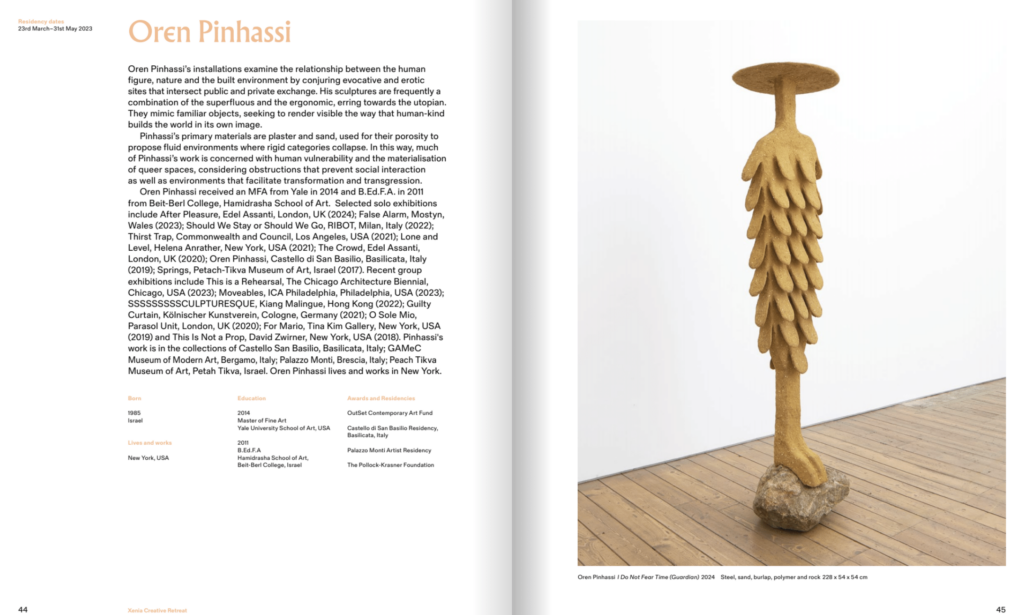
Tell us about the story behind the origins of Xenia Creative Retreat? What inspired you to establish this residency program, and how has it evolved since its beginnings?
We were in the midst of building a nice gallery for extra hanging and install space for our own artworks and sculpture and I thought how lovely it would be to have an artist working close by. I asked our architect if he thought we’d get planning consent to build an artists’ studio. It turned out that we did get consent and Stephen Marshall (architect) designed a beautiful studio with accommodation. The original concept for XCR was a simple one; to invite an artist to spend time at our place in Hampshire with the opportunity to think and make without any expectation of producing anything. What I hadn’t realised was how high the demand is from artists for residencies so since my original modest idea back in 2018, there have been huge numbers of requests from many people for a residency. We could easily fill 10 studio spaces but at least we do now have 4!
Situated amidst the picturesque countryside of Hampshire, Xenia is enveloped in the tranquility of nature. Can you offer a glimpse into what artists might anticipate during their residency at Xenia?
Artists coming for a residency to us can expect a quiet, peaceful time in the midst of an abundance of nature including plants, animals and birds. I don’t think I really need to cultivate any atmosphere as it is there anyway! We have been wilding our land so that there is no more farming and as a result, wildlife is increasing in abundance since the limiting effect of farming monoculture prevents wildlife from thriving.
For this exhibition ‘On Tenderness & Time’ you have invited curator Jenn Ellis, founder of Apsara Studio, to curate the 2024 exhibition. How important are such collaborations to Xenia?
I saw a couple of exhibitions that Jenn curated over the last 2 years and was very impressed with the quality of these and her choice of artists. It’s lovely for the Xenia residents to be able to work with somebody of Jenn’s caliber who has the skill and experience to show their work to the best advantage.
How do you foresee Xenia’s influence on the wider artistic scene, both within the local community and beyond? What aspirations do you hold for shaping the creative methods of the artists engaged in your programme?
To be quite honest, I’d like to keep Xenia small and personal! I so enjoy interacting with the artists and getting a deeper insight into their work; also seeing their work develop during their residency. I don’t have any aspirations for shaping anybody’s creative work. I hope that the magic and beauty of nature can do that as it does for pretty much everybody who is open to embracing the natural world.
